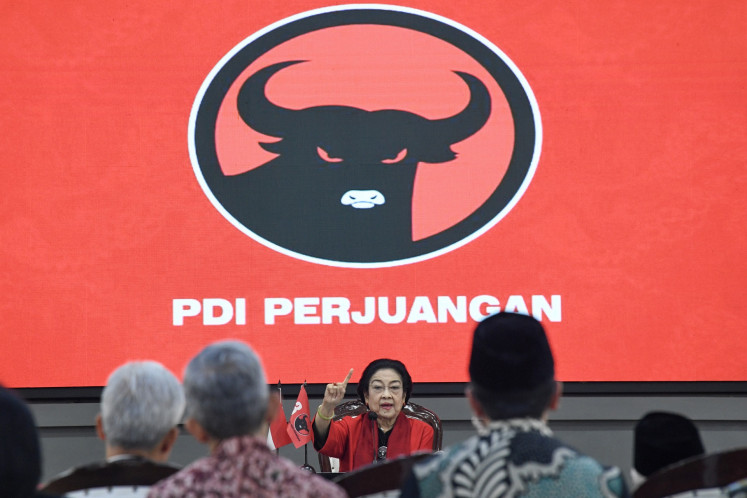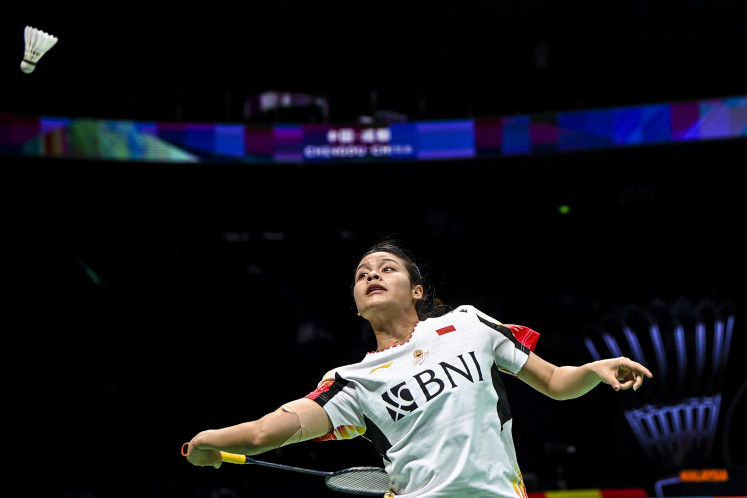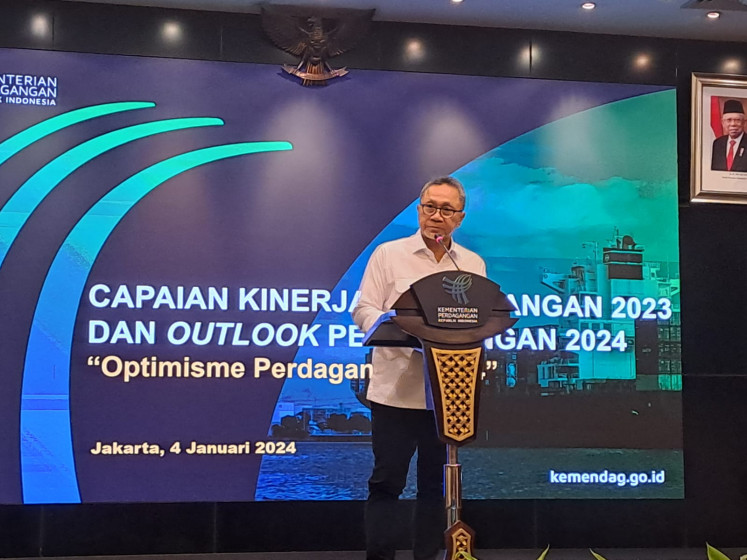What's in a name? Chinese-Indonesians have many stories
Today, people can still guess someone's Chinese family names by their Indonesian version.
Change Size
 A Chinese-Indonesian visits Vihara Dharma Bhakti, Jakarta's oldest Chinese temple, in Petak Sembilan, Glodok, in West Jakarta. (JP/Ricky Yudhistira)
A Chinese-Indonesian visits Vihara Dharma Bhakti, Jakarta's oldest Chinese temple, in Petak Sembilan, Glodok, in West Jakarta. (JP/Ricky Yudhistira)
A
lmost nobody gets it right on the first try. Since Ailen was in elementary school until university, people often misread her name as Alien. It does not help that she only has one name.
"My parents prepared my name before I was born. They had two or three names, and since my family is a traditional one, they conducted jiaobei [the moon blocks ritual]," Ailen told The Jakarta Post.
The jiaobei ritual is commonly held by Chinese people, either at home or in a temple, as a form of divination over a yes or no question. The ritual is often held after a fortune-telling ritual known as kau cim or ciam si.
The name Ailen is derived from "Ai", which is the Chinese word for love. There's also a variation of the name in Scottish, Aileen, which means light. According to Ailen, her mother wished that she would be a love that shone like the sun.
Ailen is not the only name that she has. Like many other Indonesians of Chinese descent, she also has another name: Huang Xiu Hua, which means yellow fragrant flower. It was given by her grandparents, who could speak Mandarin.
Still, even at home, with a family that holds on to rites and tradition, people do not call her by her Chinese name. "They call me Elen or 'Tot, which is short for bontot [the youngest child]," Ailen said.
Cynthia Natalia Ongga, who works in Jakarta but hails from Medan, North Sumatra, has a different story. She was born into a Cantonese family, but her family does not speak the dialect. "We were not taught because my dad is the only one from my grandparents' six children unable to speak Cantonese," Cynthia told the Post.
She and her siblings speak Hokkien instead, as the dialect is commonly used in Medan -- a city with a large Chinese-Indonesian population.
Indonesianized family names
All members of her family have Chinese names. Hers is Wang Qi Hui. In Hokkien dialect, the name Wang becomes Ong, hence her Indonesian family name Ongga.
"I have no idea how this sounds in Hokkien or Cantonese," she said of her Chinese name. "It's pronounced like chi hui so it sounds like cihui [woohoo]. I never heard it made fun of until I came here though. Back home it was just a name."
Still, some people teased her over her name. In Medan, it was her family name that became a source of ridicule.
"[People in Medan] teased me over Ongga, because it's not a very common way to nationalize the surname Wang or Ong. I guess it sounds weird to people," she said. "But they have the full context of it being a Chinese name that has been 'Indonesianized'."
In Jakarta, she finds people call her by her family name. "Here I think people mainly just think it's weird and catchy, not knowing it's a marga [family name]," Cynthia added. "It's unnatural. Who calls people by their surnames?" she asked.
Many Indonesians of Chinese descent have a complicated story behind their names, as a result of the country's history in its nation-building process. Even before Indonesia declared its independence in 1945, many Chinese-Indonesians found themselves torn between two citizenships because of different principles that were applied in China and the Dutch colony.
China applies the jus sanguinis principle, which means that every individual who is born from a Chinese parent is automatically Chinese. The Dutch colony, and later Indonesia, applied the jus soli principle, which classified every individual who was born within its borders as its subject. Despite this, the then Dutch East Indies had three classes of people, dividing society into European, Far-Eastern (including people of Chinese and Arab descent) and the native Indonesians, making Chinese-Indonesians outsiders, hence the term non-pribumi (non-native).
After Indonesia declared its independence, the first law that tried to resolve the dual-citizenship problem was the 1948 Citizenship Law, which granted all Chinese-Indonesians citizenship with the right to refuse. In 1955, then-foreign minister Sunario met his Chinese counterpart Zhou Enlai and signed the Sino-Indonesian Dual Nationality Treaty, which required Indonesians of Chinese descent to choose one nationality and to declare this in court. This requirement was then incorporated in the 1958 Citizenship Law.
According to Lan Thung Ju in his paper "Contesting the post-colonial legal construction of Chinese Indonesians as ‘foreign subjects’", which was published in the Journal of Asian Ethnicity in Sept. 2012, the requirement canceled out the citizenship granted to Chinese-Indonesians in 1948 and turned them automatically into foreigners until they chose to become Indonesian citizens.
"The process made [...] the Chinese objects of exploitation for immigration officers, a situation that continued until after the fall of [Soeharto] in May 1998," the author wrote in his paper.
Ditching Chinese names
When Soeharto took power in 1965 and formally became president in 1966, beginning the New Order period, Chinese-Indonesians were under heightened pressure to prove their Indonesian-ness. The regime introduced several policies that suppressed the Chinese part of Chinese-Indonesian people in a strategy known as assimilation. The supporters of assimilation believed that the Chinese-Indonesians would never truly become Indonesians if they did not shed the culture and habits that separated them from other Indonesians.
One of the ways was the Cabinet Presidium Decision 127 of 1966, which instructed Chinese-Indonesians to change their names into Indonesian-sounding ones. Before the New Order, some Chinese-Indonesians, mostly assimilation supporters, had changed their names, but this was by choice.
Many tried to incorporate their Chinese names in the Indonesian version. Today, people can still guess someone's Chinese family names by their Indonesian version, some notable examples being business tycoon Sudono Salim, whose Chinese name is Liem Sioe Liong, Kompas founder Petrus Kanisius Ojong, whose Chinese name is Auwjong Peng Koen and businessman Sukanto Tanoto, whose Chinese name is Chen Jianghe (Chen can be read as Tan in some dialects). Another popular surname among Chinese Indonesians is Wijaya, usually used by people whose Chinese family name is Oei (pronounced like "we") in the Hokkien dialect.
In a now-viral Twitter thread, Christa Sydney, who describes herself as "unapologetically Chinese-Indonesian", told the story of how she grew up without a Chinese name. She only asked her grandfather for a Chinese name when she was 13, and even then, she still did not know how to pronounce the name correctly.
My name is Christa Sydney. I am Chinese Indonesian. In 1st grade I was asked by a teacher what my Chinese name was, I told her I forgot. When I went home I asked my mom and I found out that I didn't have one.
— Vernon Choi stan account (@christasyd) December 21, 2019
The younger generation of Chinese-Indonesians sometimes did not know the reason behind their parents' choice of "assimilated" names.
Felicia Sugita, who was born less than a year after the 1998 Reform era, admitted that she did not know the meaning of her father's name, Sugiarto. In the Javanese language, the name is made of two words: sugih (many) and harto (fortune). The name is a common last name among Chinese-Indonesians in the island, a result of the forced attempt at assimilation.
Other discriminatory policies included a ban on celebrating Chinese New Year, locally known as Imlek, in public, the ban on speaking Chinese languages and their dialects, as well as a ban on practicing Chinese beliefs -- which forced those who believed in Confucianism to convert to other religions, mostly Buddhism, and temples to masquerade as vihara.
The policies' enforcement was strictest in Java, resulting in the loss of the ability of many Chinese-Indonesians to speak Chinese dialects. In other cities with large Chinese settlements, such as Medan and Singkawang in West Kalimantan, many traditions and dialects are still preserved.
It has only been since the Reform era that some of the pressure has been alleviated. In 2000, Chinese-Indonesians celebrated Imlek openly for the first time after then-president Abdurrahman "Gus Dur" Wahid revoked the 1967 presidential decree that banned public celebration of the spring festival. During the rule of president Megawati Soekarnoputri in 2002, Chinese New Year became a national holiday.
There is a joke among Chinese-Indonesians, which resurfaces every time there is an incident that increases tension among the Tionghoa, or when the lunar new year is near: Despite the hate, some people will come and wish us a happy new year -- if only for the angpao [red envelope filled with money].









